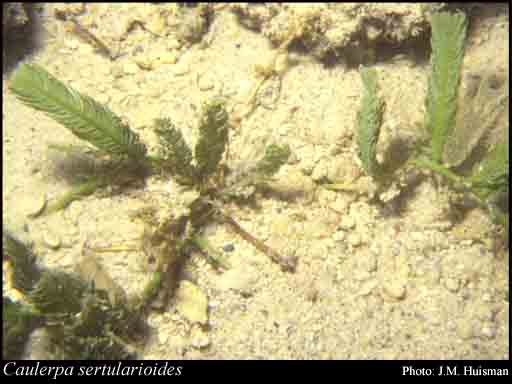- Reference
- Bull.Torrey Bot.Club 32:576 (1905)
- Conservation Code
- Not threatened
- Naturalised Status
- Native to Western Australia
- Name Status
- Current

Scientific Description
Habit and structure. Thallus pale to dark green, spreading laterally to 35 cm, with smooth stolons 0.5–1.5 mm diam., attached by pillars bearing dense rhizoidal filaments. Assimilators simple or 1 or 2 times branched, to 8 cm tall and 16 mm wide, with a terete rachis c. 1 mm diam. Ramuli distichous (rarely tristichous or crowded), closely set, terete, 4–6 mm long, curved upwards and giving the plant a feathery appearance. Assimilators mostly with ramuli from just above the base, but occasionally with naked stipes to several (rarely up to 4) cm long.
Distribution. Widely distributed in tropical seas. In W.A. south to Coral Bay.
Habitat. Epilithic in the intertidal and shallow subtidal, occasionally in sandy areas. One of the more common taxa of Caulerpa, particularly within the Ningaloo Reef lagoon.
[After Belton, Huisman & Gurgel, Algae of Australia: Mar. Benthic Algae of North-western Australia, 1. Green and Brown Algae 95 (2015)]
Distribution
- IBRA Regions
- Carnarvon, Dampierland, Northern Kimberley, Pilbara.
- IBRA Subregions
- Cape Range, Mitchell, Pindanland, Roebourne.
- IMCRA Regions
- Canning, Kimberley, Ningaloo, Pilbara (nearshore), Pilbara (offshore), Shark Bay.
- Local Government Areas (LGAs)
- Ashburton, Broome, Carnarvon, Cocos Islands, Derby-West Kimberley, Exmouth, Karratha, Port Hedland, Shark Bay, Wyndham-East Kimberley.